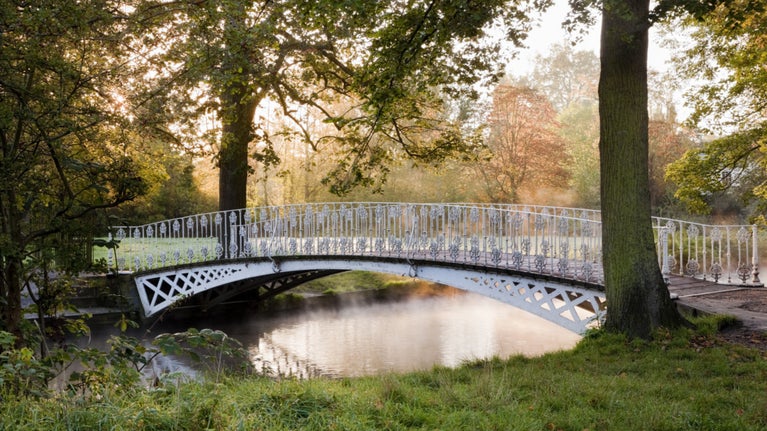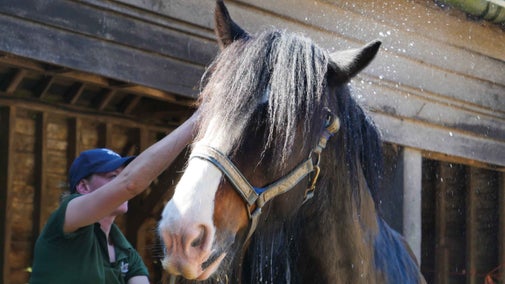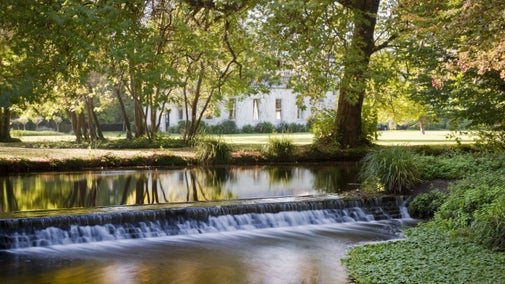
Discover more at Morden Hall Park
Find out how to get to Morden Hall Park, where to park, the things to see and do and more.

Rich in history and wildlife, Morden Hall Park has seen vast change over its almost 1,000-year history. From marshy fields to a country estate, complete with deer park and wetland, the park has also hosted a military hospital and been a place of work and industry on the River Wandle. While this history remains visible throughout the park, today it’s an oasis for the local community in the bustling suburbs of south-west London.
The first mention of the manor of Mordone comes in 1086, when it was recorded in Domesday Book as having assets of three hides (about 360 acres), one mill and seven ploughs. 14 people were recorded as living here, compared to over 100,000 who live here today. The boggy fields and marshes belonged to Westminster Abbey until the Dissolution of the Monasteries in 1536, when it was sold to two Protestant merchants, Lionel Duckett (1511–1587) and Edward Whitchurch (d.1561) for £700. Whitchurch soon bought Duckett’s share of the land and in the early 1550s built a manor house called Growtes on the site. In 1553, when Catholic Queen Mary (1516–1558) began her reign, wealthy protestants, like Whitchurch were put in a vulnerable position. As a result, he sold his manor to Richard Garth (c.1520–c.1610), a young lawyer who would be the first of five Richard Garths to use Morden as a country retreat.
When Richard Garth V (1724–87) died in 1787, the estate, complete with the newly built Morden Hall, passed to his daughter, Clara (d.1826). The sisters seemed to prefer city life in London. During this period, the Hall was let to a succession of tenants and land and buildings across the wider estate were leased out.

Two of the buildings that were leased out were the snuff mills on the River Wandle. They were built by the Garth family in around 1750 and 1830 and then let to companies to run. Snuff was big business in Britain in the 18th and 19th centuries, and the Morden Hall estate prosperity depended on these mills.
Snuff is a smokeless tobacco product made from finely ground or pulverised tobacco leaves. It is snorted or sniffed up the nose, where it releases nicotine and a scent to the user. It is made by grinding tobacco to a fine powder between two millstones. In the 18th and 19th centuries, the most efficient way to do this was to use a water wheel which turned with the flow of the River Wandle.
From 1831, a tobacco firm, Taddy & Co, was granted the lease of the snuff mills at Morden. One of the company partners was Alexander Hatfeild (1782–1865). Taddy & Co sourced their tobacco from plantations in Virginia in the United States, where enslaved people cultivated the plant. In 1815, Alexander Hatfeild married into the Gilliat family, members of which were directly involved in the enslavement of people in Virginia. This union brought him a significant cash dowry and personal connections into the lucrative tobacco and snuff business. Alexander and his son Gilliat Hatfeild (1826–1906) ran the snuff mills at Morden together.
In 1867, Gilliat Hatfeild began buying the estate which his father had been leasing since the 1830s, including the snuff mills, and the surrounding land. He also bought the Hall which was being let to William White as a ‘school for young gentlemen’.
The purchase of the estate came after the abolition of slavery in Virginia following the end of the American Civil War. Looking back during an interview with Claude W. Anderson in 1937, 85-year-old Matilda Henrietta (‘Sweet Ma’) Perry remembered the work regime on the tobacco plantations: ‘Wuk till my back felt lak it ready to pop in two. … us black people had to look arter dat ‘baccy lak it was gold.’. Land ownership remained unchanged and many formerly enslaved people, now made American citizens by the passing of the 14th amendment in 1866, remained working on the same tobacco plantations under the sharecropping or tenant system. Where it was possible to make a choice, however, they looked for work elsewhere, and by 1870, far less tobacco was being cultivated in Virginia.
Hatfeild moved his family into Morden Hall. He used his snuff milling profits to create a fashionable home that reflected the image he wanted to create of a rich businessman. At the same time, he began to design and shape the parkland, seemingly with no professional design support. He laid out a tree-lined avenue across the centre of the park to the Hall, which still survives, and installed two ornate bridges for crossing the Wandle.
The mills at Morden produced 6,000 lbs of snuff each month, in conditions described by a millworker, John Groves, as extremely dusty, noisy and uncomfortable. The snuff was blended and processed in the Taddy & Co factory, ten miles away in the Minories in the City of London. Hatfield acquired the mills in the 1860s, completing the production line and greatly expanding his successful business.
By the late 19th century, the popularity of snuff in the United Kingdom declined as cigars and later cigarettes became more affordable. Water-powered mills, like those at Morden, were outdone by steam-powered mills. After the death of Gilliat Hatfeild in 1906, his son Gilliat Edward Hatfeild (1864–1941) inherited the factory, mills and the Morden Hall estate.
In the early 1920s, the workers at Taddy & Co joined an industry-wide strike for improved conditions. Shortly after the strike, Gilliat Edward made the decision to close the company, and snuff milling in the park came to an end. The mills were repurposed as estate workshops, with the waterwheel used to power tools like planes and saws instead of milling stones.

When the First World War broke out in 1914, Hatfeild moved out of Morden Hall and loaned it to the London Hospital for use as a soldiers’ convalescent home. Patients could punt on the moat, play croquet and relax in the gardens. The Hall remained a hospital after the war, run by the Salvation Army and funded by Hatfeild from his sizeable inheritance.
The hospital catered for women and children, and the kitchen garden was put to use to feed them. Peter Kingston remembered his stay as a young child: ‘I had appendicitis, and boys just didn’t survive then. I started getting better when I got [to Morden] as I didn’t have to eat the horrible food we were given at London Hospital.’
After moving out of Morden Hall, Gilliat Edward Hatfeild moved into Morden Cottage, just behind the snuff mills. Gilliat Edward was a keen gardener, and after the closure of the mills in 1921, he created a 2.5 acre rose garden just outside the cottage. Historical images show the garden’s layout of 48 irregular rectangular and circular beds of standard and climbing roses on poles.
The experience of watching recovering soldiers, and then children, enjoy the park may have encouraged Hatfeild to throw annual parties for local people. Swings, slides, punts, round-a-bouts and presents were all regular features. The grandson of the Morden estate bailiff remembered ‘jellies, ice cream, sandwiches, cake, fruit and lemonade’ in the 1930s. Olive and Tom also remembered going to the parties: ‘Both of us were from working-class families and we didn’t have a lot. It was a magical day! There were marquees full of trestle tables with party food like sandwiches and cakes. Inside the park was a fairground attraction with helter-skelters and swing boats and punts going up and down the river taking people for rides round the islands. When we left we were given a goody bag of an apple.’

In the mid-1920s, the underground Northern line reached Morden, just west of the estate. This signalled the end of Morden as a rural village separate from London. By 1936, the park was surrounded by modern housing estates. One estate included London’s first cycle lane and an experimental set of pedestrian crossing lights, along St Helier Avenue. Hatfeild tried to block these developments, wanting to maintain the park and village as he knew it, and to prevent the felling of long-lived woodland.
Even as the area changed, the park remained much the same until the Second World War. The use of the Hall as a hospital continued, but the rest of the park was put to new uses. An air raid shelter was built close to the Hall as well as anti-tank defences, trenches and an ammunition store. Bombs damaged many of the park’s cottages and glasshouses.
Gilliat Edward Hatfeild died aged 77 in 1941 and was described in local obituaries as 'a well-known figure who enshrined in his own personality many virtues of the old English country squire with none of his faults or failings’ He left the Hall and the surrounding estate to the National Trust ‘for the benefit of the public ... provided that a fee shall not be charged for admission’. The National Trust immediately let the Hall as local government offices and opened the park to the public when the Second World War ended in 1945. The hall has since become a wedding venue, where the 18th-century plasterwork and carved fireplaces created for the Garth family remain a key feature.
In the 1860s, Gilliat Hatfield was the last man to create and design a private park in London, just for his family’s enjoyment. In 1941, his son gave Morden Hall and its surrounding park to the National Trust as green space for the city’s inhabitants to enjoy and find beauty. Some aspects of this legacy are still visible; for example, the well-tended rose garden continues to flourish, and the rustic bridges commissioned by Gilliat Edward in 1921 have been recreated and installed in 2025. The park’s importance to the community is demonstrated in the groups of people who come together with the National Trust to look after it, in the local schoolchildren looking for kingfishers on the banks of the Wandle, in the breath of fresh air while a local resident walks their dog. The park is open to all and enjoyed by many, each in their own way.

Find out how to get to Morden Hall Park, where to park, the things to see and do and more.
Discover more of the history of this waterside wildlife habitat in the Wandle Valley, one of the National Trust’s first acquisitions and just a short walk from Morden Hall Park.

Learn about how we‘ve preserved traditional methods of looking after the land and the wildlife that lives there, and find out how you can get involved.

From river and wetland walks, to remnants of the park's history and an adventure playground for the little ones, see how the park changes along with the seasons.

Find out the family-friendly things to do at Morden Hall Park from taking part in trails to watching outdoor theatre and spotting wildlife such as wetland birds.

Thinking about volunteering at this special place? Here’s what you need to know.

Learn about people from the past, discover remarkable works of art and brush up on your knowledge of architecture and gardens.
